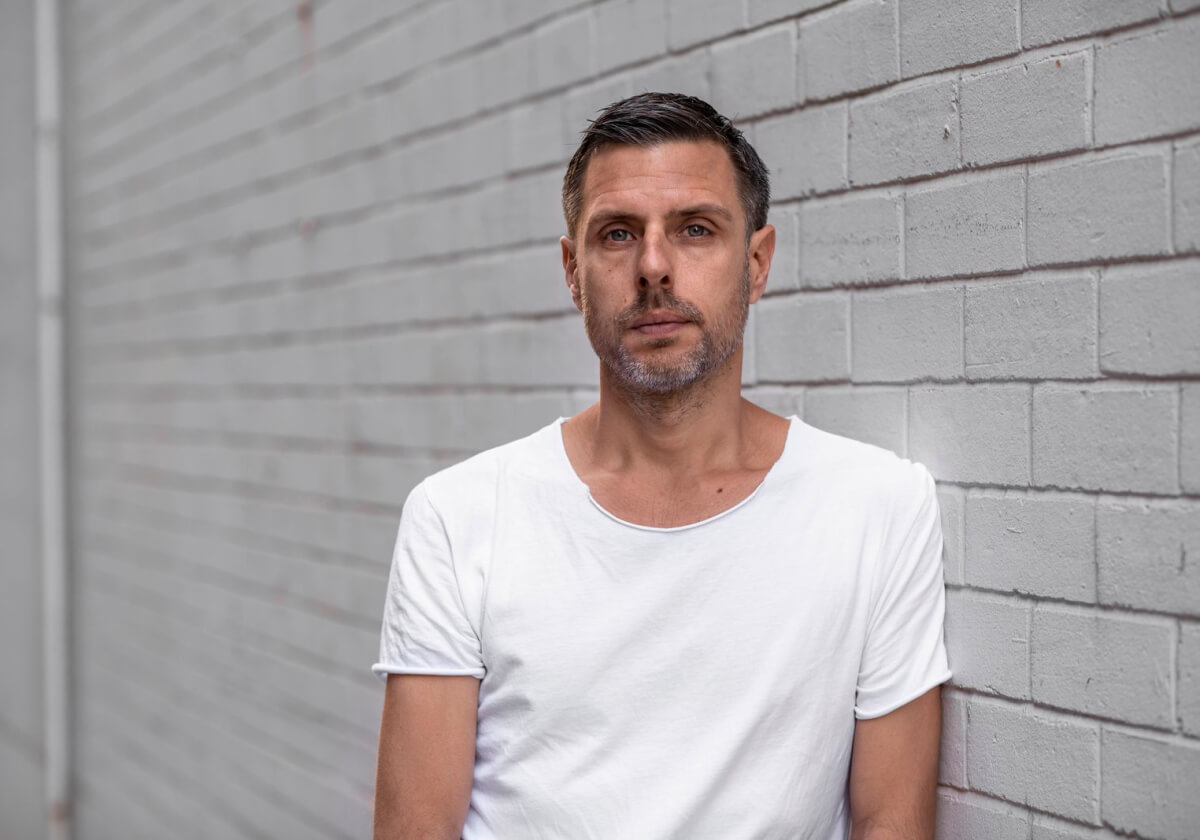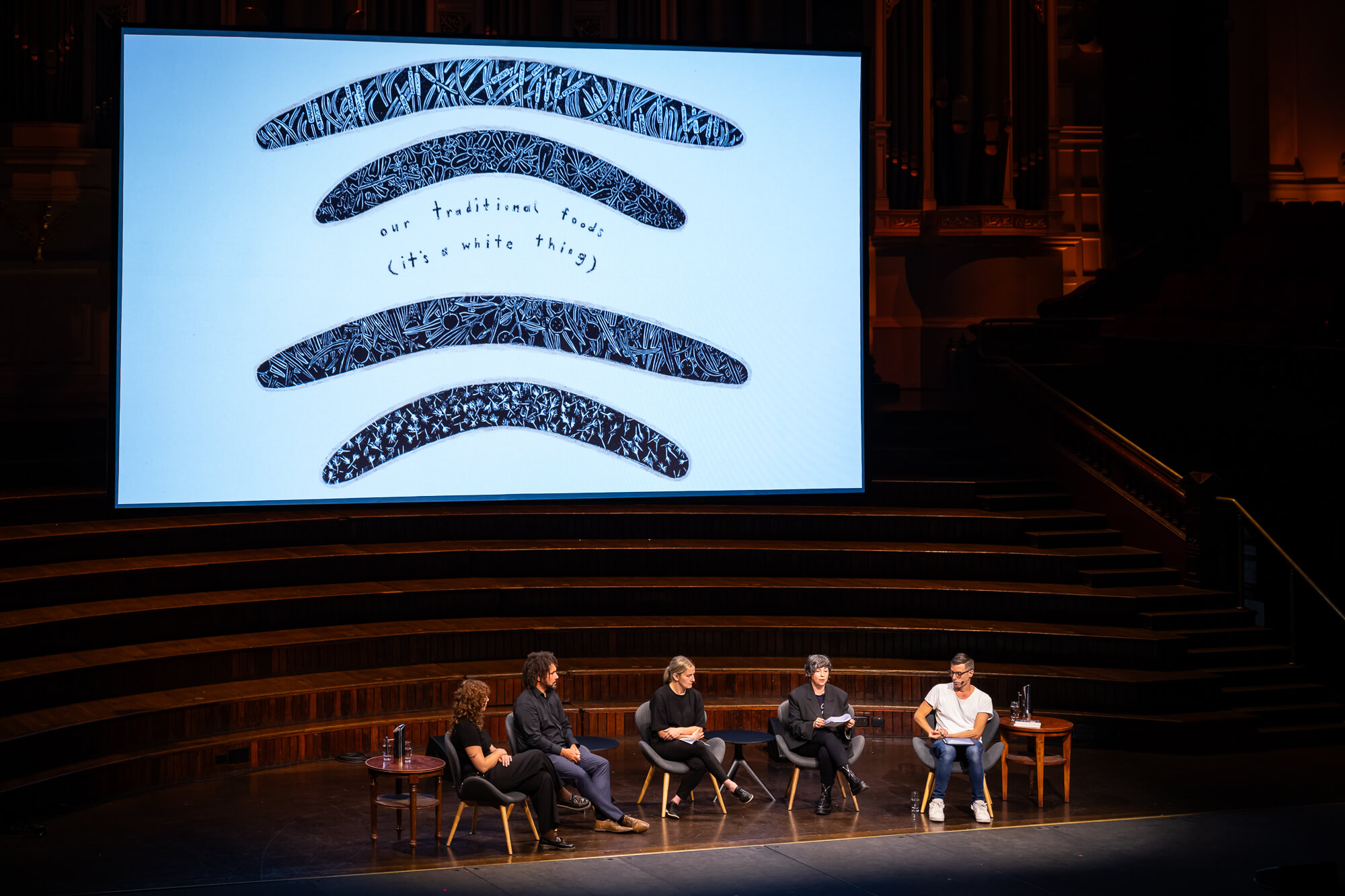Past Event
LIVING HERITAGE: sites, objects, language, plants and sky
- hosted by artist Jonathan Jones

As part of its global Symposia, held in 2023 in Sydney, the International Council for Monuments and Sites (ICOMOS), invited Jonathan Jones, renowned Wiradyuri/Kamilaroi artist and researcher to deliver the keynote Heritage Lecture, in a wonderful re-scripting of the idea of heritage as something that lives and breathes alongside us.
Following a short lecture Jonathan introduced panelists for the evening:
- Erin Rose, Gunditjmara, Executive Officer Budj Bim World Heritage at Gunditj Mirring Traditional Owners Aboriginal Corporation
- Juanita Kelly-Mundine, West Bundjalung woman and First Nations Art Conservator, Art Gallery of NSW
- Nathan Brennan, Gumbaynggirr, Bundjalung and Gamilaraay man and part of the Ngiyambandigay Wajaarr Aboriginal Corporation
- Zena Cumpston, Barkandji woman and writer, researcher, artist and storyteller.
The event was well-attended, with over 800 in the main chamber at Sydney Town Hall on George Street. To open proceedings, Jonathan thanked the audience for attending to listen and learn - recognising this as a powerful act, saying that seeking knowledge is seen in Wiradjuri culture as an action of great wisdom.
Watch on demand
Jonathan took his audience on a trip around the south-east of Australia, a region, he explains, with its own ecology and landscapes, very different from the typical red sand and sparse desert images of Aboriginal Australia typically conjured up by many in the international audience.
The south-east of Australia encompasses over 70 language groups across Victoria, parts of NSW and South Australia. The south-east has an extraordinarily long cultural heritage such as sites in the Willandra Lakes Region of Western NSW, which include the world’s oldest known ritual burial ground at Lake Mungo; one of the world’s oldest human-made structures in the Ngunnhu Brewarrina Fish Traps in north-western NSW; and one of the world’s most extensive and oldest aquaculture systems at the vast Gunditjmara aquaculture site, part of the Budj Bim Cultural Landscape in Western Victoria.
Jonathan went on to describe the impact that a lack of access to your own Country – or of decision-making power over it - can have on the rich continuity of culture.
Respect for deep history and living heritage
Better access and agency over their own lands and understanding and respect for its deep history and living heritage was a core theme across each of the panellists when responding to Jonathan’s questions. A lack of knowledge and understanding was laid bare by Nathan:
"Language is an expression of a worldview, so when you lose a language, you lose that worldview."
Nathan Brennan
It’s often not something we talk about as heritage, however there are so many concepts and so much knowledge encased in a word like ‘Country’, which we really do not have the words to fully describe in English.
Perhaps not having a shared language contributes to modern Australia’s lack of understanding, value and respect described. Jonathan’s newly created scar-tree could now be seen as an important cultural marker, not just for local Wiradjuri, but for everyone in the area. Instead, it was fenced off by council for fear of defacement or vandalism.
This lack of respect of cultural sites and monuments is stark says Jonathan, when comparing for example the deliberate burning of a sacred Dja Dja Wurrung birthing tree in 2021 in central Victoria was almost unreported; and what Jonathan described as “the global outpouring of grief” for the destruction of Notre Dame in 2019.

What is needed to decolonise Country?
The panel was asked the impediments to improving this access and understanding, or put another way, what is needed to decolonise Country, and systems around it. Nathan raised the example of cultural burning of lands and called for more trust an autonomy in managing parks and lands, recognising Aboriginal cultural practice has evolved over millennia to be exactly right for the natural landscape of Australia.
Erin’s experiences of actively managing cultural sites echo these common experiences discussed of access and agency, understanding and respect. The 9,935ha Bunj Bim Cultural Landscape was listed as a World Heritage Site in 2019. This listing elevated the site’s profile and led to funding boosts for site management. However, alongside this there is a different vulnerability now in the site’s profile and visibility, something Erin and the Gunditj Mirring Traditional Owners are conscious of.
In contrast to a growing understanding of Bunj Bim’s significance, Zena spoke about the surprising lack of understanding and engagement in mainstream Australian food culture, of traditional foods – grasses, greens, berries and roots, which provided the staple diet for millennia, and plants which are uniquely suited to Australia’s harsh and dry conditions.
Juanita Kelly-Mundine is acutely conscious she is one of only three Aboriginal people working as a conservator in NSW, a surprisingly small number when you consider the incredibly long and rich cultural offerings here in NSW. Juanita describes herself as being “early in her career” but carrying a “heavy burden” of knowledge deeply vulnerable to being lost.
She spoke about breathing new life into objects, hearing their stories and what they can teach us. Juanita often invites elders or other community to assist in conserving objects from a particular country, agreeing methods together. Through this practice she has now become custodian of a multitude of practices now passed on to her from these knowledge holders.
In speaking of respect, Zena’s research into Australia’s bush-foods industry exposed a shocking lack of engagement, consultation or acknowledgement of ancient cultural knowledge when commodifying Aboriginal foodways. Her research has underlined a lack of uniform laws and regulations around cultural ownership and rights to knowledge.
In closing this incredible panel, Jonathan asks everyone to “hold on to the knowledge learned today and share it, talk about it, and one day we can all move forward together”.
Aboriginal kinship systems are such that each person feels a particular kinship with a bird, animal, or plant. “This translates crudely into English as a ‘totem’.
"Imagine the system of kinship, or care, which could be built if all Australians were gifted a totem. A living part of Country placed in their care. This could extend to schools, sporting teams, even corporations."
Jonathan Jones
What a powerful way all Australians could share our landscape and place, taking shared custodianship for it for our futures.
About the speakers
Jonathan Jones is a Wiradyuri/Kamilaroi artist and researcher. Jones is a researcher at Jumbunna Institute for Indigenous Education and Research, University of Technology Sydney.
Juanita Kelly-Mundine is a West Bundjalung woman engaged in cultural heritage conservation and protection of cultural property. Juanita is the First Nations Art Conservator at the Art Gallery of New South Wales.
Erin Rose is Gunditjmara from South West Victoria and is a delegate of the Budj Bim Cultural Landscape World Heritage Area, one of the world’s oldest Aquaculture systems. Erin is the Budj Bim World Heritage Executive Officer at Gunditj Mirring Traditional Owners Aboriginal Cooperation overseeing the management and protection of the Budj Bim Cultural Landscape and its values.
Zena Cumpston is a Barkandji woman who works as a writer, researcher, artist and storyteller. Zena was a co-author of the 2021 State of the Environment Report, working across several chapters and recently co-authored the book 'Plants: past, present and future' as part of the First Knowledges series. She is particularly passionate about plants and the many ways they illuminate the ingenuity and scientific knowledge of her people.
Nathan Brennan is a Gumbaynggirr, Bundjalung and Gamilaraay man. He is passionate about Aboriginal language revitalisation and teaching, Aboriginal led land and sea country management and threatened species management. He is part of the Ngiyambandigay Wajaarr Aboriginal Corporation, which has been developed to create opportunities for a holistic approach for Gumbaynggirr people to reacquire our land for the continuation of cultural practice, conservation, healing and social and economic development.
Jonathan Jones. Photo: Mark Pokorny
